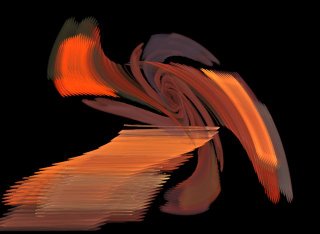Thought Thinking; or, Recursion I Think
"A society made up of individuals who were all capable of original thought would probably be unendurable. " - Henry Louis Mencken
"One original thought is worth a thousand mindless quotings." - anon
Last night, as I continued to read more from Gleick's book on Chaos, I again found my mind wandering to all sorts of related and exciting thoughts. In particular, I was reading about John Hubbard's work exploring Newton's method for solving equations in elementary calculus. Any equation would have two solutions, one real and one imaginary (involving the root of -1). Basically, the traditional method was to "guess" an approximation, then use that in an iterative process to refine the answer. If you were converging on an answer, you were verifying that your original guess was sound and the ultimate answer would be correct; if diverging, you were approaching the irrational answer, and so simply guessed again. At least that's how I interpreted it. It's really not important because Hubbard wanted to use a computer to do two things: a) take the "guess" out of the procedure, and b) extend the procedure to a polynomial of degree-3 (ah! where have we heard of a pattern of three before?!!).
Long story short, with much pondering and musings between himself and his students when they didn't get the expected results, they came to realize an astounding, and on the surface, seemingly impossible condition. The expectation was that a flat surface would be divided into three more-or-less wedge-shaped pieces, each piece representing the plots that would lead to one of the three possible answers. A ploynomial of degree-3 has 3 answers, because it has 'added' an extra dimension ... it's like the difference between locating a point on a line or locating a point on a surface.
They expected that the three surface parts would be separated from each other by a line of some particular curvature .... if the point is on one side of the line, answer #1 satisfies the equation for those co-ordinates, on the other side, then the other answer satisfies it. They plotted solution points in three different colours to develop a map of the solution. What they found, though, remarkably was that for every point between areas, all three colours occured! That's equivalent, in a sense, of saying you have three-dimensions to a two-dimensional object. How could that be?
"A boundary between two colours never quite forms. ... no point serves as a boundary between just two colours. Wherever two colours try to come together, the third always inserts itself, with a series of new, self-similar intrusions. Impossibly, every boundary point borders a region of each of the three colours.... magnified segments reveal a fractal structure, repeating the basic pattern on smaller and smaller scales" (Gleick: p.219-220)
It turns out that each point is a fractal. If magnified enough, it is a replicate of the entire original mapping. You see that characteristic with fractal-drawing programs. As you "zoom in" on a piece of the fractal, the same patterns re-emerge.
So what? What's that got to do with 'is'? Well, just about everything for one thing! One of the fundamental characteristics that I attributed to each and every 'dot' was not only that it contains the potential for {'everything', oneness, wholeness....}, but it has the innate capacity to {"give birth to itself", recreate, reproduce, fractalize, recurse....}. I must be honest in telling you that I developed a serious case of goosebumps. As I read through the various works of different {scientists, mathematicians, social scientists, biologists, philosophers...} I am noticing the Universal Pattern that I have suggested becoming more and more re-inforced by this diversity of opinion and study. It's simultaneously a freaky kind of feeling, as well as a calming, reaffirming one. And if the theory is what it says it is, that should be the case. For the theory says that an entity exists along with its single, three-faced alternate: a) exact opposite, b) exact clone (or absence of opposite), and c) mirror image (or reverse of). So my goosebumps should be countered by an inner sense of awe and comprehension (the goosebumps being an hyperbole for a physical mainfestation of incomprehensiblity!).
Now it's starting to sound like an ego trip, though, isn't it? How dare I put myself in the same league as these mental giants? The league of human beings capable of holding a thought or two and putting it into a perspective of an interest domain? The unmitigated nerve! After all, I flunked out of University, have never had a paper published, and the only laboratory that I've been in was one studying insect pathology when I was a kid working at a summer job in high school forty years ago.
But, as I mentioned before, I have two things going for me. I have the deep personal understanding of my own intuition (which comes from itself, and which most of these researchers shared as a common characteristic, even though it was counter-intuitive in almost every case to the 'accepted' thinking of the day), and I have the expertise of 57 years of being a layperson... expertise I draw on heavily since, if you read yesterday's blog, in essence my theory is re-building the bunny's ass that's already been eaten, and identifying which molecule will be consumed next. My theory provides for reconstructing the whole from any of its constituent parts, much like the holographic metaphor I've used in the past.
Which begs the final question..."What's all that got to do with "Thought Thinking", the title of today's blog? As I said yesterday, this entry would be about ideas, imagination, first thought and original thought, seeds of thought and the linkages between and amongst them.
I'm proposing that a thought {evolves from, grows out of, develops from...} an idea. Stating that another way, in mirrored language; an idea is the seed of a thought (just as an acorn is the seed of a tree). I've spent several blog entries discussing this concept (tracing back thoughtlines, the "giant sucking ShopVac, etc.). So where does an idea come from? From itself, of course...same as a thought. An entity has the capacity to create itself. There's proof right there, if you need it. "I just had the idea that an idea can create an idea". I did! And it did! Can you prove that I didn't?!! Or it didn't? An idea is just a seed, a beginning. It's the "hello!" of a conversation, and from that the conversation then flows. You have them every day without giving pause to think about it, it comes so naturally to all of us.
What do the following have in common?
1)History log of sites you've visited today, yesterday, this week. (There's likely an icon on your tool bar up top there that will show it to you)
2)"Hansel and Gretel"
3) The "goBack" program from Norton, that let's you re-establish the state of your computer at some designated point in the past if you've screwed up something, or picked up a virus.
4) reverse engineering
5) car rally check points
6) modular design and trouble shooting
7) Sherlock Holmes
8) "a penny for your thoughts".
9) "her mind is an open book"
10) "I just knew you were going to say that"
11) deja vu
12) "isn't this about where we came in?"
I could go on infinitely, but I hope you recognize they are all traceback mechanisms. Ways of going where every thought has gone before. Whoa up ther kiddo! How do you jump from "a penny for my thoughts" to every thought in one single step for mankind. The same way that Hubbard discovered each dot contained a fractal of the whole design within itself. It just depends what layer or level of thinking you're operating at.
And that brings me to the topic for tomorrow's blog. Levels and layers of thinking. Going where 'no' man has gone before (even though, enigmatically, we've all been there already...potentially, at least). Peel yourself an onion tonight, and while you're doing that, imagine that it contains a built-in elevator from the very core to beyond the outer surface. (The imagination allows us to do this sort of construct). Now put a similar elevator accessing every atom and quark (up, down, top, bottom, strange and charm variety) of the onion, including all the ones between the layers, the ones in the juices as well as the solid part, and don't forget the 'gases' that make your eyes water. And while you're doing it, also ponder this: If I can traceback this blog to yesterday's, and trace it forward to tomorrow's (which hasn't been written yet, and therefore doesn't 'exist' yet), and as with the rabbits, trace it to all things coincidental, (and all things are always coincidental), then can I claim that I am the holder of the first thought that ever sprang from the first idea that ever was? Can everyone? Why can't everyone, if they can't?
Levels and layers of thinking. Going where 'no' man has gone before (even though, enigmatically, we've all been there already...potentially, at least). Peel yourself an onion tonight, and while you're doing that, imagine that it contains a built-in elevator from the very core to beyond the outer surface. (The imagination allows us to do this sort of construct). Now put a similar elevator accessing every atom and quark (up, down, top, bottom, strange and charm variety) of the onion, including all the ones between the layers, the ones in the juices as well as the solid part, and don't forget the 'gases' that make your eyes water. And while you're doing it, also ponder this: If I can traceback this blog to yesterday's, and trace it forward to tomorrow's (which hasn't been written yet, and therefore doesn't 'exist' yet), and as with the rabbits, trace it to all things coincidental, (and all things are always coincidental), then can I claim that I am the holder of the first thought that ever sprang from the first idea that ever was? Can everyone? Why can't everyone, if they can't?
"To know something, and to know that you know it, are two different things" - either original or plagarized from somewhere unknown.
___________________________________________________


"I've learned that you can't hide a piece of broccoli in your glass of milk." - Age 7
PEACE












You lost me.
Posted by My Daily Struggles |
11:27 a.m.
My Daily Struggles |
11:27 a.m.
Bummer! And I thought I was doing so well unfolding my thought patterns. Heavy sigh! Maybe when you this in conjunction with the next entry it'll be a little less fuzzy....and then again, maybe not. Hope so.
Do you know 'where' I lost you?
Posted by Evydense |
6:51 p.m.
Evydense |
6:51 p.m.
I see I left out the word 'read' in my previous comment....I'm curious about why that was. It wasn't intentional (see next blog entry), but it suggests there are different ways of absorbing the message than simply through reading it....so why should I bias you by suggesting how you should ___ it?
Posted by Evydense |
6:54 p.m.
Evydense |
6:54 p.m.
Post a Comment